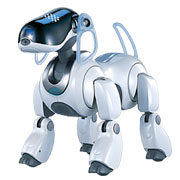are u interested in robotics???
By vidyadas
@vidyadas (415)
India
3 responses
@varuntr (643)
• India
1 Dec 06
Biomimetic robots are those which are inspired by nature. They borrow their structure and senses from animals, such as humans or insects. Their abilities are copied from earth's greatest examples of success, living organisms; they tend to function better in the unpredictable real world than the controlled artifice of a laboratory. Robotics engineers are able to blend expertise from the fields of biology and computer engineering. A wealth of biological data together with advances in low-cost, power efficient computer systems support the emerging development of robots that mimic insect and sea creature adaptations to environmental niches.
Biomimetic robots borrow their structure and senses from animals, such as humans or insects. Their abilities are copied from earth's greatest examples of success, living organisms; they tend to function better in the unpredictable real world than the controlled artifice of a laboratory. Robotics engineers are able to blend expertise from the fields of biology and engineering.
Strides made in biological research mean we know much more about how animals survive, for instance deep-sea creatures' sensory organs or geckos' gravity-defying feet. The speed, power, and size of computers mean we can create programs that mimic neurophysiologic brain functions. Reverse engineering (tracking a result through its process to its source) has as a tenet that the cause exists. Therefore, just knowing there is an animal that can track moving objects while flying through space without visible light, proves that it's possible.
To picture such a biomimetic robot, you might consider its method of locomotion. Remember, such a robot would never have wheels on an axle, but might wriggle like a worm or hop like a bird. It might have sensory "organs," like an instrument to measure temperature. Also, its abilities will probably be something humans aren't adept at, like locating underwater mines, or can't do quickly enough.
Ultimately, an ideal biomimetic robot performs its tasks autonomously, without constant human direction. It will be able to move, gather sensory information, interact with its environment, and make decisions all by itself. The army may one day employ robot dogs that act as pack-assistants to carry a soldier's supplies into difficult terrain. Given below are some biomimetic robots
1 person likes this
@varuntr (643)
• India
1 Dec 06
Biomimetic robots are those which are inspired by nature. They borrow their structure and senses from animals, such as humans or insects. Their abilities are copied from earth's greatest examples of success, living organisms; they tend to function better in the unpredictable real world than the controlled artifice of a laboratory. Robotics engineers are able to blend expertise from the fields of biology and computer engineering. A wealth of biological data together with advances in low-cost, power efficient computer systems support the emerging development of robots that mimic insect and sea creature adaptations to environmental niches.
Biomimetic robots borrow their structure and senses from animals, such as humans or insects. Their abilities are copied from earth's greatest examples of success, living organisms; they tend to function better in the unpredictable real world than the controlled artifice of a laboratory. Robotics engineers are able to blend expertise from the fields of biology and engineering.
Strides made in biological research mean we know much more about how animals survive, for instance deep-sea creatures' sensory organs or geckos' gravity-defying feet. The speed, power, and size of computers mean we can create programs that mimic neurophysiologic brain functions. Reverse engineering (tracking a result through its process to its source) has as a tenet that the cause exists. Therefore, just knowing there is an animal that can track moving objects while flying through space without visible light, proves that it's possible.
To picture such a biomimetic robot, you might consider its method of locomotion. Remember, such a robot would never have wheels on an axle, but might wriggle like a worm or hop like a bird. It might have sensory "organs," like an instrument to measure temperature. Also, its abilities will probably be something humans aren't adept at, like locating underwater mines, or can't do quickly enough.
Ultimately, an ideal biomimetic robot performs its tasks autonomously, without constant human direction. It will be able to move, gather sensory information, interact with its environment, and make decisions all by itself. The army may one day employ robot dogs that act as pack-assistants to carry a soldier's supplies into difficult terrain. Given below are some biomimetic robots
@vinaykiran28 (5149)
• India
30 Nov 06
i am interested in it, are you? can you give me more info regarding robotics
1 person likes this







